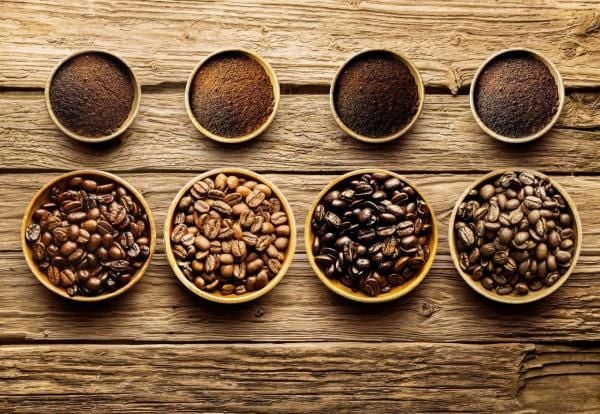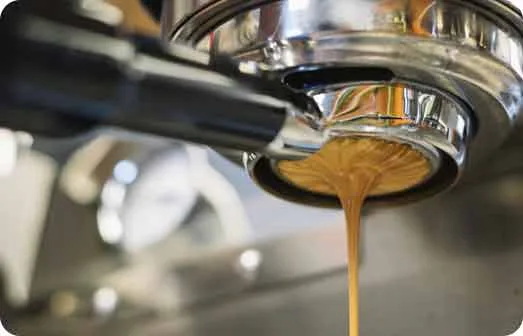Some examples: Screen 18 coffee has a bean size of 7.2 mm; Screen 16 coffee has a bean size of 6.3 mm; Screen 13 coffee has a bean size of 5 mm… The maximum percentage of black or broken beans in wet-processed coffee is usually 0.2%, while for dry-processed coffee, it can be up to 2%.
Coffee Roasting Stage
In the clean coffee production process, the roasting stage is the most important and plays a decisive role in the quality of the final product. Under the effect of heat, chemical reactions take place, forming the characteristic flavor and color of coffee.
Coffee Roasting Machine
After the roasting process, the mechanical strength of the coffee beans decreases while their brittleness increases. As a result, the beans break apart more easily under mechanical force during the grinding process.
Changes in Coffee Composition During Roasting
Caramelization and Maillard reactions occur during roasting, forming the dark brown exterior and reddish-brown interior of the coffee bean.
The aroma of coffee is created through several reactions:
-
The Maillard reaction produces aromatic aldehyde complexes.
-
The decomposition of quinic acid leads to the formation of aromatic alcohols such as hydroquinone, pyrogallol, phenol, and catechol.
-
The decomposition of caffeic acid results in compounds like catechol, vinyl catechol, and ethyl catechol.
The flavor is also formed during roasting:
-
Sourness comes from acids such as citric acid, malic acid, lactic acid, pyruvic acid, and acetic acid.
-
Bitterness is derived from caffeine and products of the caramelization and Maillard reactions.
Coffee Cooling Stage
Purpose:
After roasting, coffee retains a high temperature, which causes newly formed aromatic compounds to continue evaporating, leading to flavor loss. To preserve the aroma, coffee must be cooled as quickly as possible after roasting.
Changes During Cooling:
Even during the cooling process, volatile aromatic compounds continue to evaporate. Additionally, due to the residual heat, chemical reactions—especially caramelization and Maillard reactions—may still occur, causing the beans to darken further. The faster the coffee is cooled, the less aroma is lost.
At first glance, this stage may seem insignificant. However, for a professional roaster, it is crucial. From the moment they smell the aroma to when they see the fully cooled beans, this step evokes an indescribable emotion.
Coffee Grinding Stage
Purpose:
The main purpose of grinding roasted coffee beans is to reduce their size and break down the original structure of the beans, making it easier for the brewing process when needed. Grinding also helps release gases that were trapped during roasting.
Grinding coffee is a very important step and directly affects the quality of the final cup. If your coffee grinder is not good and the beans are ground unevenly, brewing will be more difficult and the quality of the coffee will be compromised.
The standard for grinding coffee is that the beans must be ground evenly and finely, with minimal heat generation (ideally using cutting technology that slices the beans into equal parts). This explains why some coffee grinders can cost several thousand dollars.
Currently, the highest grinding standards in the world are those used for professional espresso machines.
Transformations:
During the grinding process, gases such as CO₂, water vapor, and other volatile substances are released. The degree of gas release depends on the grind size. Grinding also causes a loss of aroma because some compounds evaporate. Therefore, coffee should be used immediately after grinding to ensure the best quality. If not used right away, it must be stored in an airtight bag to avoid exposure to air.
Conclusion:
The above is a basic overview of the clean coffee production and processing process. In reality, roasting and grinding clean coffee is much more complex. For example, each type of coffee requires a different roasting method and post-roast handling. Likewise, different brewing methods also require different roasting and grinding profiles (e.g., roasting and grinding for drip coffee differs from that for espresso machines).
The purpose of this article is to share with everyone the most basic clean coffee production process. Soon, I will write a more detailed article covering the entire process—from cultivation to brewing. Stay tuned!
 Peach Americano
1 × 3 $
Peach Americano
1 × 3 $ Salted Cream Phin Coffee
1 × 2 $
Salted Cream Phin Coffee
1 × 2 $ CAFE ICE LATTE
1 × 2 $
CAFE ICE LATTE
1 × 2 $

